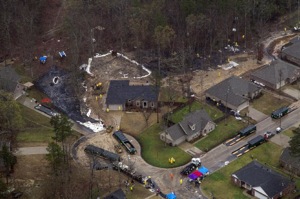Soil and sediment samples taken about four months after an Exxon Mobil pipeline ruptured and spilled thick crude oil into a Mayflower neighborhood showed that a Lake Conway cove was still contaminated enough with petroleum-related products to cause ecological but not human concerns, a state agency said Wednesday.

“We’re reassured that the results don’t show a public health threat,” said Tammie Hynum, the chief of the Hazardous Waste Division of the Arkansas Department of Environmental Quality.
Hynum said, however, that “the results do show a need for continued remediation to eliminate ecological concerns, particularly in the cove. We have not seen an environmental impact to the main body of Lake Conway.”
“We’ve seen nothing to indicate there are any concerns with the consumption of fish,” said Ryan Benefield, the department’s director. The oil constituents from the March 29 rupture that were found “would be a concern for the fish themselves.”
Benefield said the findings indicate more remediation is needed in the areas affected but were “not unexpected given the magnitude of the spill.” The agency will require Exxon Mobil to handle that remedial work, he said.
Eighteen samples were taken in late July in the main part of the popular fishing spot, and 269 samples in total were taken in areas leading to that area: three ditches, the cove’s marshy area and the cove’s watery area, Benefield said. No spill-related oil constituents, including hydrocarbons and volatile organic compounds, were found in the primary part of the lake, he said.
“We didn’t see any-thing that would pose a human-health or an ecological concern in the main body of the lake,” Benefield added. “We’ve seen no evidence that oil … has reached the main body of the lake.”
The 850-mile-long Pegasus pipeline, which runs from Illinois to the Texas Gulf Coast, transported a form of oil called diluted bitumen. This kind of oil, harvested in Canada, is so thick that it is diluted with chemicals, including the carcinogen benzene, to help the oil flow. Exxon Mobil has not restarted the pipeline since the rupture.
Environmental Quality Department spokesman Katherine Benenati said, “Benzene was not found at a level of concern/risk to ecological habitat in our preliminary review.” Lead, nickel and cadmium were among the contaminants found, she said.
State, local and federal officials, along with Exxon Mobil, have long said the estimated 210,000 gallons of heavy crude reached the ditches and the cove but not the rest of the lake in the hours after the Pegasus pipeline ruptured on the afternoon of Good Friday. But some area residents have repeatedly said they believed that the oil had spread farther.
Ed Barham, a spokesman for the Arkansas Department of Health, agreed with Benefield that consumption of fish from the cove is not dangerous to humans.
Of the contaminants, Barham said, “They’re metabolized so quickly through the fish, they’re never absorbed. We’ve not been very concerned about that although we still have discussions about the testing program.”
Keith Stephens, spokesman for the Game and Fish Commission, which oversees the man-made lake, said some wildlife creatures have begun to return to the cove, which because of the cleanup no longer is as abundant in vegetation as it once was. For a time, workers even moved some creatures such as small cricket frogs away from the cove.
“There are some animals that are coming back,” Stephens said. “Obviously there aren’t as many as there were before. We feel confident that eventually it will get” back to normal.
Benefield said it wasn’t necessary to keep aquatic life away from the cove now. Any danger to fish would be from “longer-term exposure,” not immediate, he said. “The [aquatic] community can still be there. It can still thrive.”
Asked if dredging would be required, Benefield said, “We haven’t gotten to that point yet. Once we know the full extent of the contamination,” that can be decided. “There could be a chance of what I call a dig-and-haul,” where more soil is brought in, or there could be another form of remediation, he said.
Water sampling is continuing. Sediment samples will resume if the department decides more are needed.
Sampling is being done by a contractor paid for by Exxon Mobil but overseen by the Environmental Quality Department, Benefield said. The sampling method must be approved by the U.S. Environmental Protection Agency and must go through a laboratory certified by the state agency, he said.
The state department has asked Exxon Mobil to submit a final data report documenting the sediment, soil and surface water sampling activities and summarizing field and analytical data no later than Friday. .
Exxon Mobil spokesman Aaron Stryk said the company plans to submit its report at that time. “In the meantime, we’re still analyzing the data,” he said in an email.
He said an ongoing assessment of the cove, which includes soil, sediment and water sampling, will help “determine the best work plan.”
Confirmation of the lingering contamination in the cove did not surprise the Arkansas attorney general’s office, which has joined with the U.S. attorney’s office in a federal lawsuit against Exxon Mobil Corp. and two of its subsidiaries.
“We suspected that the cove area would require significant remediation at significant cost to Exxon Mobil,” said Aaron Sadler, a spokesman for Attorney General Dustin McDaniel.
Arkansas, Pages 9 on 10/10/2013